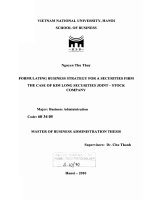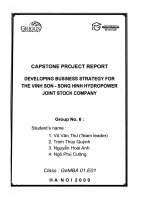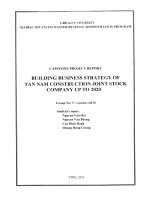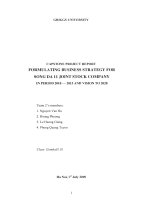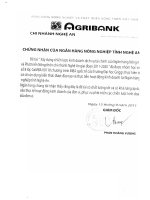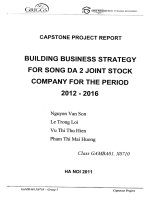Building up the strategy of Saigon value investment joint stock company 2011 - 2015
Bạn đang xem bản rút gọn của tài liệu. Xem và tải ngay bản đầy đủ của tài liệu tại đây (1.33 MB, 75 trang )
Building up the strategy of SVI 2011 - 2015
Capstone Group N0. 4
- 1 -
GRIGGS UNIVERSITY
GLOBAL ADVANCED MASTER OF BUSINESS ADMINISTRATION PROGRAM
CAPSTONE PROJECT REPORT
BUILDING UP THE STRATEGY OF
SAIGON VALUE INVESTMENT JOINT
STOCK COMPANY 2011 - 2015
Group Number : 4
Student ‘s name
1. Do Quang Duc
2. Nguyen Thi Hai Ha
3. Tran Thi Thuy Ha
4. Pham Dao Minh Quan
5. Vo Trong Tu
HO CHI MINH 2011
Building up the strategy of SVI 2011 - 2015
Capstone Group N0. 4
- 2 -
TABLE OF CONTENT
INTRODUCTION 9
1.General background 9
2.Importance of the studied topic 9
3.Research purposes 9
4. Research methodology 10
5.Scope of research 11
6.Studies subject 11
CHAPTER 1: THEORETICAL BASIS ON STRATEGIC MANAGEMENT
AND MANAGEMENT STRATEGY OF INVESTMENT FUND 11
1.1.Overview of strategic management 11
1.1.1. Concept 11
1.1.2. Role and characteristics of strategic management for the enterprise
12
1.1.3. Process of strategic management 12
1.1.4. Strategic levels 16
1.2. Some tools used to evaluate and propose business strategies 16
1.2.1. External factor evaluation matrix (EFE) 16
1.2.2. Internal factor evaluation matrix (IFE) 18
1.2.3. Competitive profile matrix 19
1.2.4. SWOT Matrix 20
1.2.5. Strategic position and action evaluation matrix - SPACE Matrix 22
1.2.6. Strategic selection: Quantative strategic planning matrix (QSPM) 22
Building up the strategy of SVI 2011 - 2015
Capstone Group N0. 4
- 3 -
1.3. Core competencies 23
1.4.Basic concept on investment fund 24
1.4.1. Concept of the role of investment fund 24
1.4.2. Legal basis to establish investment fund 24
1.4.3. Types of operating investment funds today 24
CHAPTER 2: REAL SITUATION ANALYSIS OF SAIGON VALUE
INVESTMENT JOINT STOCK COMPANY 26
2.1 General introduction on the company 26
2.1.1. Formation and development history 26
2.1.2. Organization chart 27
2.1.3. Necessity for strategic planning for SVI investment fund 27
2.1.4. SVI investment fund’s operation 28
2.1.4.1. Investment trust services 28
2.1.4.2. Capital arrangement services 28
2.1.4.3. Support services of Stock Exchange HOSE, HASTC 29
2.1.4.4. Consulting services of bond issue 30
2.1.5. Investment regulation 31
2.1.5.1. Investment objectives 31
2.1.5.2. Investment policies 31
2.1.5.3. Investment restrictions 32
2.1.5.4. Handling losses 33
2.1.6. Areas and sectors of investment 34
2.1.7. Transaction process and fee table at SVI 34
Building up the strategy of SVI 2011 - 2015
Capstone Group N0. 4
- 4 -
2.2. The company's real situation analysis of the business environment 36
2.2.1. Analysis of macro environment impacting on the company’s activities .
36
2.2.1.1. Legal - political environment 36
2.2.1.2. Economic environment 36
2.2.1.3. Socio-cultural environment 38
2.2.1.4. Information technology systems 38
2.2.2. Micro environment 38
2.2.2.1. Potential rivals 38
2.2.2.2. Competition among rivals in the industry 39
2.2.2.3. Pressure from buyers (customers) 40
2.2.2.4. Pressure from suppliers 40
2.2.2.5. Pressure from substitute products 41
2.2.3. Analysis of internal industry 41
2.2.3.1. Financial strength 41
2.2.3.2. Human Resources 42
2.2.3.3. Business administration capacity 42
2.2.3.4. Brand 42
2.2.4. Results of operations in 2010 and plans in 2011 43
2.2.4.1. Results of business operations in 2010 43
2.2.4.2 Business operation plan in 2011 43
2.2.4.3. Results of business operations in early six months in 2011 44
2.3.The existing restriction of SVI 45
Building up the strategy of SVI 2011 - 2015
Capstone Group N0. 4
- 5 -
CHAPTER 3: OPERATION AND DEVELOPMENT STRATEGY
ORIENTATION OF INVESTMENT FUND OF SAIGON VALUE
INVESTMENT DURING THE PERIOD OF 2011 – 2015 46
3.1.Core values, vision, mission 46
3.1.1 Core values 46
3.1.2 Vision and mission 47
3.1.2.1 Vision 47
3.1.2.2 Mission 47
3.2. Business strategy goal from 2011 – 2015 47
3.2.1. Short term objectives 47
3.2.2. Long-term objectives 48
3.3. Strategic assessment and choice method through the matrices 48
3.3.1. Internal factor evaluation matrix 49
3.3.2. External factor evaluation matrix 50
3.3.3. SWOT matrix analysis 51
3.3.4. Space matrix 53
3.3.5. Competitive profile matrix of SVI 56
3.3.6. Strategic selection through QSPM matrix analysis 57
3.4. Strategic implementation solution 60
3.4.1. Capital mobilization and use in the more efficent way 60
3.4.2. Customer development 61
3.4.3. Development and improvement for new products – services 61
3.4.4. Professional activity development 63
Building up the strategy of SVI 2011 - 2015
Capstone Group N0. 4
- 6 -
3.4.5. Network , operation scale expansion 64
3.4.6. Human strategy 64
3.4.7. Investment and development of information technology and service
systems 66
3.5. Recommendations 68
3.5.1. Recommendations for the State 68
3.5.1.1. Macroeconomic stability maintainance 68
3.5.1.2. Development and improvement of legal systems 69
3.5.1.3. The state should encourage and actively support the formation and
development of investment funds 69
3.5.1.4. Implementing tax incentive policies for securities investment activities
of investment funds 70
3.5.2. Recommendations for Saigon Value Investment Joint Stock Company
71
CONCLUSION 72
REFERENCE MATERIALS 73
APPENDIX 73
- Follow up day-trade 74
- Call option 75
INDEX OF TABLES AND FIGURES
Figure 1-1: Comprehensive strategic management model …………………13
Figure 1-2: Michael E. Porter’s five competitive forces model 15
- Table 1: Internal factor evaluation matrix 49
- Table 2: External factor evaluation matrix 50
Building up the strategy of SVI 2011 - 2015
Capstone Group N0. 4
- 7 -
- Table 3: SWOT matrix analysis 51
- Table 4: Space matrix 53
- Table 5: Competitive profile matrix of SVI 56
- Table 6: Strategic selection through QSPM matrix analysis 58
- Chart 1: Earnings in the first six months of year 2011 44
- Chart 2: Space matrix chart 55
Building up the strategy of SVI 2011 - 2015
Capstone Group N0. 4
- 8 -
ACKNOWLEDGEMENTS
Understanding of each person as a grain of sand in the desert
vastness of the knowledge base, capture knowledge and creativity is
never ending for those who have progressive spirit and want to rise
in life, Group 4 joined in training program Master of international
business Administration from National University of Hanoi with
Griggs University (USA) nor for purposes in addition to socio-
cultural knowledge, skills ability to improve their lives Vietnam
proverb that said, " "No guide, no realization"," Thank the program,
thank the teachers for whole-hearted
Teaching and teaching assistants, who guide and suggestions for all
assignments, and share knowledge and experience in your lives for
the class in general and for particular group 4.
We wish the teachers and your family are healthy; the program will
be growing to help train more people with more knowledge to
society. /.
Group 4 - Class GaMBA01-C0210
Building up the strategy of SVI 2011 - 2015
Capstone Group N0. 4
- 9 -
INTRODUCTION
1. General background:
Today, in the context of the global economy as well as of Vietnam, there
are fierce competitions which are taking place in all areas of business operation, a
business which wants to survive and develop no longer is based on experience and
the elements of chance as before, and now to survive and thrive in the
marketplace, the most important and necessary thing is to direct its business to go
on a path consistent with development trends and to be able flexible for the change
of the business environment in order to achieve high fitness, ensuring
sustainability for the business. To achieve this, there is nothing else, the
companies must identify and develop a business strategy for their business,
because business strategy is basis, guideline for all activities of the business.
2. Importance of the studied topic:
Investment Fund of Saigon Value Invest Joint Stock Company (SVI) was
founded in 2010 at the same time, the world and Vietnam economic situation was
complicated, requiring the company must have long-term development strategies
and simultaneously having timely adaption to surrounding conditions, combining
with the advantages of internal resources and external opportunities for the
company to be more sustainable development.
3. Research purposes:
- To assess the impacts of external environment, analyzing the
macroeconomic factors affecting investment fund, through which finding the
image of external environment of the enterprise (EFE).
- To carry out analyzing on the perspective of business manager for the
operational aspects of SVI investment fund, from which to build the internal
factors of the enterprise (IFE).
Building up the strategy of SVI 2011 - 2015
Capstone Group N0. 4
- 10 -
- To analyze the two internal aspects of the organization (Financial Strength
(FS), competitive advantage (CA)), and two external aspects: environmental
stability (ES) and industry strength (IS) from which showing the company's
strategy through strategic position and action evaluation matrix (SPACE).
- To combine IFE and EFE creates analysis matrix of the strengths and
weaknesses, opportunities for the business, from which choosing general strategy
to develop investment fund and construct development strategy of the company in
the next 5 years.
4. Research methodology:
- Analyzing the impacts of the world and Vietnam economic environment,
using the model of five competitive forces of Michael E. Porter to analyze the five
competitive forces on the industry.
- EFE matrix analysis to determine the response of SVI with the market.
- IFE matrix analysis.
- Competitive profile analysis.
- SPACE analysis.
- QSPM matrix analysis.
To form the development strategy of the company, through the
establishment of some matrices from which choosing develop strategy of the
company in the next period. Research data is secondary data obtained through
books, magazines, statistics, references of judgement of leaders from the fund
companies with sizes similar to SVI.
From combining the internal and external matrices, SWOT matrix and
competitive profile matrix, our group will analyze QSPM matrix and our group
will select appropriate strategy for SVI.
Building up the strategy of SVI 2011 - 2015
Capstone Group N0. 4
- 11 -
5. Scope of research:
The growth of investment funds is concentrated in two major cities of
Hanoi and Ho Chi Minh, but as the time and conditions is limited, our group will
only carry out studying mainly in Hochiminh area.
6. Studied subject:
SVI‟s operation is primary and investment funds in Ho Chi Minh city have
a operation capital less than VND50 billion.
CHAPTER 1: THEORETICAL BASIS ON STRATEGIC MANAGEMENT
AND MANAGEMENT STRATEGY OF INVESTMENT FUND
1.1. Overview of strategic management:
1.1.1. Concept:
Business strategy is an overall plan to control and use organizational
resources in the specific conditions of the business environment with the aim at
improving its competitiveness.
According to Fred R. David, strategic management can be defined as an art
and establishment science, implementation and evaluation of decisions related to
allowable functions of an organization to achieve those goals. In other words,
strategic management focuses on integrating the management, marketing, finance
and accounting, manufacturing, development research and information systems
and business areas to achieve the success of the organization. Strategic
management is a system of decisions and actions to establish and implement plans
to achieve the business‟s goals.
Building up the strategy of SVI 2011 - 2015
Capstone Group N0. 4
- 12 -
1.1.2. Role and characteristics of strategic management for the
enterprise:
In a similar business markets, each company has a special power, a
particular business condition so the detailed planning of strategy is completely
different. Henderson wrote that "the difference among strategies is prudent
search of an action plan to develop and combine competitive advantage of the
organization. Things are different from you and your competitors are the
basis for your advantage," can not exist two competitors if their business
practices are identical. Should create differences then may exist.
Therefore, in any era and for any field of business, planning process of
business strategy is always one of the first tasks of the business. Every business
must develop strategies in accordance with the internal factors and external factors
of the own enterprise in each period of business, must be ready to grasp as real
opportunity appears as well as stopping the potential risks by setting in advance
the assumptions can occur.
Business strategy planning is both outline process of the assumptions as the
basis for building the company's goals, and helping the coordination of the
activities which need to be undertaken to accomplish the goal and simultaneously
it‟s also control tool of the initial assumptions by comparing actual results with
expected results which have been outlined in the plan to evaluate and carry out
adjusting if necessary.
1.1.3. Strategic management process:
According to Fred R. David, strategic management consists of three
phases: phases of strategic formation, strategic implementation and strategic
evaluation.
Building up the strategy of SVI 2011 - 2015
Capstone Group N0. 4
- 13 -
Figure 1-1: Comprehensive strategic management model
1.1.3.1. Strategic formation stage:
Strategic formation is process of establishing business tasks, performing
research investigation to determine the internal and external defect factors,
working out long-term goals and choosing alternative strategies. Three basic
activities in the strategic formation include research, intuitive harmony and
analysis, and making decisions.
Since no organization has unlimited resources the strategists must make
decisions in connection with selecting what alternative strategies will make the
most benefit for the company. Decisions in the strategic formation stage will
Study environment to
identify main
opportunities and threats
Review business
objectives
Identify the
current tasks,
goals and
strategies
Establish long-term goals
Internal control to identify
the strengths and
weaknesses
Construct and select
strategies to implement
Set short goals
Distribute
resources
Measure and
evaluate results
Propose policies
Distribution
information
Feedback
Form strategy
Implement
strategy
Evaluate
strategy
Building up the strategy of SVI 2011 - 2015
Capstone Group N0. 4
- 14 -
connect the organization with products, markets, resources and specific
technologies in a long time. The strategies clearly define the competitive
advantage in the long term. The strategic decisions have long-term effects or better
or worse for the organization and there are primary multi-functional consequences.
The strategists have the best vision to understand all the ramifications of the
formation of decisions, and they are entitled to connect necessary resources to the
implementation.
Situational analysis includes the external and internal environment. This
analysis often includes political, environmental, social and technological analysis,
analysis of the factors affecting the organization and analysis of the strengths,
weaknesses, opportunities and challenges.
To study the business environment is considered as the most important
stage and is the first step of the strategic construction and management process.
The environment factors of a business include the following contents:
- The macro environment of the business: includes economic, political,
social factors, and natural factors and scientific – technological factors.
Micro-environment of the enterprise are external factors for the enterprise,
determining the nature and extent of competition in the business production
industry. Applying the model of Michael E Porter's five competitive forces to
analyze this environment will helps managers see the competitive factors which
have directly impacted on the enterprise.
Building up the strategy of SVI 2011 - 2015
Capstone Group N0. 4
- 15 -
Figure 1-2: Michael E. Porter’s five competitive forces model
1.1.3.2. Strategy implementation phase:
This is the action phase of strategic management. Three basic operations of
the strategic implementation are establishing annual goals, making policies and
resource distribution. The strategic implementation is often considered as the most
difficult stage in the process of strategic management, it requires discipline and
sacrifice of every individual. The strategy is proposed but not implemented will
not serve any useful purpose.
1.1.3.3. Strategic evaluation:
Three operations of this period are: reviewing the factors as the basis for the
current strategy; achievement measurement and implementation of the adjustment
operations. Strategic evaluation phase is necessary because the current success
does not guarantee success in the future! The success always creates new
Potential new
rivals
Suppliers
Subsitutes
Competitors in the
industry
Competition among
enterprises present
in the industry
Buyers
Bargaining power
of suppliers
Bargaining
power of buyers
Risk of new
competitors
Building up the strategy of SVI 2011 - 2015
Capstone Group N0. 4
- 16 -
problems, organizations with satisfactory ideology that must pay the penalty for
perish.
1.1.4. Strategic levels:
1.1.4.1. Corporate-level strategy:
The process of growth and development of the company usually consists of four
main phase:
- Phase 1: Activities in the domestic market on a business field.
- Phase 2: Strengthening and maintaining competitiveness, the company
can implement vertical integration or external market expansion, activity
globalization.
- Phase 3: The company implements diversification and expands operations
into new business areas.
- Phase 4: Cut down and change.
Normally, companies think about operation diversification strategy as
having created extra financial resources, beyond the needed level to maintain and
enhance competitive advantage in main business field. Diversification can enhance
the value chain, strengthen the competitive position of the company.
1.1.4.2. Business level strategy:
Three main factors are foundation for the strategic choice of the
corporation.
- Customer demand and product differentiation.
- Group of customers and market segments.
- Distinguishable capacity is defined as the way which the company uses to
meet customer needs in order to achieve competitive advantage.
1.2. Some tools used to evaluate and propose business strategies:
1.2.1. External factor evaluation matrix (EFE)
Building up the strategy of SVI 2011 - 2015
Capstone Group N0. 4
- 17 -
External factor evaluation matrix (EFE) summarizes and quantifies the
influences of external environmental factors for the enterprise. Construction of
EFE matrix is similar to building IFE matrix. It can briefly state as follows:
Table1.2. External factor evaluation matrix (EFE)
External factors
Weight
Rating
Summary
(1)
(2)
(3)
(4)
Total
1,0
- Column (1) lists from 10 to 20 factors, including the opportunities and
threats affecting the company and the company's business industry
- Column (2) records the weight of the factors with the strategic position of
the company with the range from 0.0 (not important) to 1.0 (very important) for
each factor. This assessment is based on the industry. The total weight of the
factors must equal 1.0
- Column (3) the level of assessment: 4 - very strong, 3 - strong, 2 - quite
weak, 1 - very weak
- Column (4) obtained score = column 2 x column 3
- Total score accrued in the 4 column shows the strategy of the company
takes advantage of external opportunities and minimizing the negative effects of
the external environment.
Building up the strategy of SVI 2011 - 2015
Capstone Group N0. 4
- 18 -
1.2.2. Internal factor evaluation matrix (IFE):
Internal factor evaluation matrix (IFE) evaluates the important strengths
and weaknesses of the functional departments of the business. IFE matrix is built
in five steps:
- Step 1: Determine the list in the range from 10 to 20 important factors,
including the strengths and weaknesses of the business. These factors are listed in
column 1.
- Step 2: Identify the weight to assess importance for the strategic position
of the company from 0.0 (not important) to 1.0 (very important) for each factor.
The total of the importance of all factors must equal 1.0. These values are recorded
respectively in column 2
- Step 3: Each enterprise will assess itself the impact of each factor for the
enterprise.
The degrees of assessment: 4 - very strong, 3 - strong, 2 - quite weak, 1 - very
weak
- Step 4: Multiply the weight of each factor with the level of their impact (=
column 2 x column 3) to determine the total impact. The results are recorded in
column 4
- Step 5: Sum the total score of importance for each factor to determine the
total important score for the organization.
No matter how many factors IFE matrix have the total score of the highest
importance that a company can achieve is 4.0, the lowest is 1.0 and the average is
2.5.
Building up the strategy of SVI 2011 - 2015
Capstone Group N0. 4
- 19 -
Internal factors
Weight
Rating
Summary
(1)
(2)
(3)
(4)
Total
1,0
1.2.3. Competitive profile matrix
Competitive profile matrix allows us to identify the major competitors
along with their advantages and disadvantages. This matrix is the expansion of
external factor evaluation matrix by introducing the key factors of the internal
environment in order to compare among competitors in the industry.
The specific steps to develop tools of evaluation matrix for business
internal environment factors include:
- Step 1: Make a list of factors which are crucial to the competitiveness of
enterprises in a business industry (ranging from 10 to 20 factors).
- Step 2: Assign importance by sorting from 0.0 (not important) to 1.0
(most important) for each factor. Be noted that the importance which is assigned
for the factors shows the relative importance of that factor with the success of the
inbusiness industry. Thus, for the business in the industry, the importance of the
factors listed in step 1 is the same.
- Step 3: Classify from 1 to 4 for each element, the type of each element
depends on the response level of corporate for that factor, in which: 4 - good
response, 3 – response above average, 2 - average response, 1 - weak response.
- Step 4: Calculate score for each factor by multiplying the importance of
that element with the corresponding classified score.
Building up the strategy of SVI 2011 - 2015
Capstone Group N0. 4
- 20 -
- Step 5: Calculate the total score for all elements given in the matrix by
adding the score of corresponding component factors of every business. Total
score shows the competitiveness of businesses. Accordingly, if the total score of
the entire list of factors are put in the matrix from 2.5 or more, the business is
competitive on average. In contrast, the total score in the matrix is less than 2.5,
the competitiveness of the enterprise is lower than the average.
1.2.4. SWOT Matrix:
The purpose of the SWOT matrix analysis (Strengths, Weaknesses,
Opportunities, Threats) is to analyze coordination of the strengths and weaknesses
of the business with the opportunities and threats in order to appropriately
coordinate among elements to assess and identify and select appropriate business
strategy for the enterprise. SWOT matrix has nine cells in which four cells are
important factors, 4 strategic cells are the intersection cells of the appropriate
boxes describing the strategic ideals and an empty cell. SWOT matrix is built
according to the following basic steps:
- Step 1: List opportunities impacting strongly the field which the business
needs to study.
- Step 2: List market threats that may occur.
- Step 3: List the strengths of the business.
- Step 4: List the weaknesses of the business.
- Step 5: Combine the internal strengths and external opportunities (S / O
cell).
- Step 6: Combine internal weaknesses and external opportunities (W / O
cell), take advantage of external opportunities to overcome internal
weaknesses.
Building up the strategy of SVI 2011 - 2015
Capstone Group N0. 4
- 21 -
- Step 7: Combine internal strengths and external threats (S / T cell), take
maximum advantage of the internal strengths to overcome external threats.
- Step 8: Combine internal weaknesses and external threats (W / T cell), to
take advantage of opportunities to overcome weaknesses
Table 1.3. SWOT Matrix
SWOT
Opportunities: (0): 0
1
, 0
2
…
Threats (T): T1, T2…
Strengths (S)
S
1
, S
2…
S / O: The strategy takes
advantage of opportunity by
using the strengths
S / T: The strategy uses
strengths to overcome
threats
Weaknesses (W)
W
1
, W
2
W / O: The strategy takes
advantage of opportunity to
remedy weaknesses
W / T: Minimizing the
weaknesses to avoid threats
Analysis and evaluation by SWOT matrix is aimed at determining the
strengths (S - Strength), weaknesses (W - Weakness), opportunities (O -
Opportunities), threats (T - Threats) from the effects of business environment for
the firm to from which giving strategies and solutions to promote strengths and
overcome weaknesses, take advantage of opportunities, limit and control
challenges.Matrix of strengths - weaknesses, opportunities - threats (SWOT) is
important combining tool which can help managers develop four types of
following strategies:
Building up the strategy of SVI 2011 - 2015
Capstone Group N0. 4
- 22 -
- The strategies of strengths - opportunities (SO): use the internal strengths
of the company to take advantage of external opportunities.
- The strategies of weaknesses - opportunities (WO) aim at improving
internal weaknesses by taking advantage of external opportunities.
- The strategies of strengths - threats (ST): use the strengths of a company
to avoid or reduce the impact of external threats.
- The strategies of weaknesses - threats (WT): These are the defense
strategies to reduce internal weaknesses and avoid external threats.
1.2.5. Strategic position and action evaluation matrix - SPACE matrix:
SPACE Matrix shows that a business should choose strategy: Conservative,
cautious, defensive, or competitive. The axes of the matrix have the following
meanings:
- FS : Financials Strengths
- CA: Competitive Advantage
- ES : Enviroment Stability
- IS: Internal Strenghts
1.2.6. Strategic selection: Quantative strategic planning matrix
(QSPM):
Based on the Quantitative Strategic Planning Matrix - QSPM, is a tool that
enables the strategists objectively assess alternative strategies. According to Fred
R. David, to build the QSPM matrix includes 6 steps:
- List of external opportunities / threats and the internal weaknesses /
strengths.
- Classification for each internal and external critical successful factors.
- Research the matrices at the stage 2 and identify possible alternative
strategies that organizations should consider for implementation.
Building up the strategy of SVI 2011 - 2015
Capstone Group N0. 4
- 23 -
- Identification of the attractive score.
- Calculate the total attractive score.
- Sum attractive score. That‟s addition of total attractive score in the
strategic columns of the QSPM matrix. The degree of difference between total
attractive score in any strategy shows the relative attractiveness of this strategy
compared with other strategies.
1.3. Core competencies: (Honors, "Strategy Integrates" www.jmbruton.com)
- Competitive advantage is derived from the rare resources and capabilities on the
market. Businesses create a competitive advantage over rivals through the
development of their core competency, they are competencies as below:
- Allows businesses to differentiate products / services compared to other
competitors.
- As a basic to create competitive advantage;
- Creating the best performance when based on invisible resources and good
organization competence.
In order to maintain a strong competitive advantage for businesses, core
competencies must have four conditions (VRIN):
- Valuable: to enable businesses to differentiate products / services and create
unique value.
- Rare: the competitors can not reach;
- Inimitable: the competitors can not easily copied or produced;
- Non-substitutable: resources equivalent to create a similar strategy which is not
available;
Core competencies can be technology, technical secrets, relationships with
customers, distribution network, strong brand. Core competencies to create
competitive advantage for businesses in the service business activities
Building up the strategy of SVI 2011 - 2015
Capstone Group N0. 4
- 24 -
1.4. Basic matters on investment fund
1.4.1. Concept of the role of investment fund
Investment fund is the non-bank financial institution which raises capital by
the general form of investment capital or a set of multi-ownership capital from
contributions of individuals and organizations with money want to invest together
to enhance the professionalism of the investment. Fund will be implemented by
investment professionals, representing for the investors, into an asset portfolio
which is designed according to the policy of the fund.
According to the 2006 Securities Law, securities investment fund is the
fund formed from contribution capital by investors for the purpose of profit from
investments in securities or other types of investment assets, including real estate,
in which investors have no control over daily decision-making for investment
fund.
1.4.2. Legal basis to establish investment fund
According to the item 3, article 19 of the Government Decree
144/2003/ND-CP on securities and securities market, the securities investment
fund is the fund which is formed from the contribution capital of investment trust
person for fund Management Company who manages and invests at least 60%
value of fund assets in stocks.
1.4.3. Types of present operating investment funds
1.4.3.1. Public fund
Public fund is securities investment fund which implements offer of fund
certificates to the public. Public funds have 2 types of close fund and open fund:
Close fund: is the public fund which fund certificates have been offered to
the public and not being acquired at the request of investors. In order to
create liquidity for this type of fund, after ending the capital mobilization
Building up the strategy of SVI 2011 - 2015
Capstone Group N0. 4
- 25 -
(or closing fund), the fund certificates will be listed on the stock market.
Investors can buy or sell to its recover stock capital or investment
certificates through the secondary market. Total mobilized funds of the
fixed and unchanging fund while the capital fund works.
Open fund: is the public fund that fund certificates have been offered to the
public that must be acquired at the request of investors. This type of fund
has the number of fluctuating capital and membership. With this form, the
sale and purchase transactions of fund certificates are made directly with
the fund management company and fund certificates are not listed on the
stock market. Due to high liquidity requirements, the form of opening fund
usually only appears in the nations with developed economy and stock
market such as the United States, Canada, UK, Germany, Japan
1.4.3.2. Membership fund
Membership fund is a securities investment fund which is established by
capital contributed by a certain number of investors and fund certificates are not
released to the public.
Under securities law, membership fund is securities investment fund which
has its members participating in contributing capital does not exceed 30 members.
Members of the fund are usually professional investors and have strong
financial capacity as finance companies, banks or insurance companies. The main
objective of the establishment of a member fund is to carry out relatively risky
investment activities. These investment operations can bring very high potential
profit. The capital contributed partners are entitled to participate in fund
management more than investors in public fund, and simultaneously their risk
tolerated abilities is more better, so that the member fund does not bear many
investment restrictions as public fund investment.
